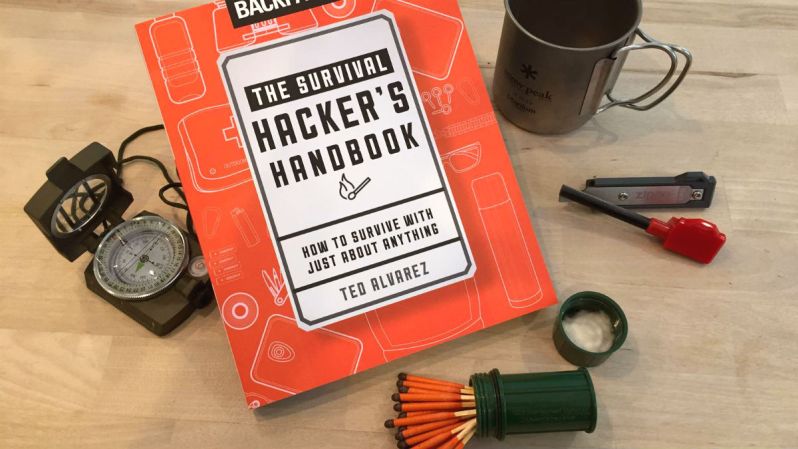Among the things I’m hoping I never have to deal with are a grizzly bear attack, an avalanche, and being caught in the middle of a flash flood. I also don’t want to find myself miles away from civilization and without fresh water. And come to think of it, I don’t want to deal with a gushing flesh wound, either.
But, if any of those things happen, I’ll be better prepared to face them thanks to Ted Alvarez’s enjoyable, informative new book, The Survival Hacker’s Handbook

Alvarez has been a writer and editor for Backpacker magazine for many years, and he’s a lifelong, avid outdoorsman. After some open-minded self-assessment, he realized that, despite all that time spent plying the fields, forests, and mountains, he wasn’t actually all that prepared for a genuine survival situation. So he did what any sensible person would and began to regularly plunge himself into wilderness survival scenarios, testing out techniques and gear, devising his own new survival tricks and strategies, and finding out much of what works and what doesn’t when a person is far afield and on their own.
First, a word of caution: Reading The Survival Hacker’s Handbook does not make you ready to survive alone and without proper gear and provisions. Only practical experience does that. Reading this book will, however, serve as a great first step toward developing backwoods survival skills, and can help you plan your own survival training program, assemble your own wilderness supply list, and ready your mind for the challenges you might one day face out there in the wild.
Also, reading this book is a good way to spend an afternoon or two, because unlike many such guides, it is written with compelling, often amusing prose. You can select chapters and sections that are of particular interest or which might be germane to a given situation (say you just got lost, you have no water, but you do have your copy of the book, for example).

I’d recommend you just read the thing straight through. Taken as a whole, The Survival Hacker’s Handbook covers just about every topic required for making it through a survival ordeal, from preparing shelters to finding safe sources of food to treating injuries to navigation to handling various dangers and on and on. It is also organized in a logical way for front to back reading, starting off covering the absolute essentials (shelter, water, food) and progressing later to topics that are important, but not universally critical. (You always need shelter, hydration, and nourishment, e.g., but you might not always be facing a wild fire risk or dealing with a broken leg.)
Another good reason to read The Survival Hacker’s Handbook in its entirety is the fact that, as a quick-reference guide, this book isn’t all that helpful. The information is shared in story and essay-style writing, not in quick bullet points. If you try to depend on this book in an actual crisis, you’re probably in trouble. Acquiring the knowledge Alvarez has to share requires a thorough reading of each section, so don’t wait to study up on this or that survival technique in a pinch. Read the book now for fun, then read it again before your next outing, and practice some of the techniques covered too. Then hope that the re-reading and practice were ultimately a waste of time, because good read or not, no one ever wants to actually need to employ the content covered in this book.
You should also read our list of backpacking essentials and how to assemble a DIY emergency kit.




